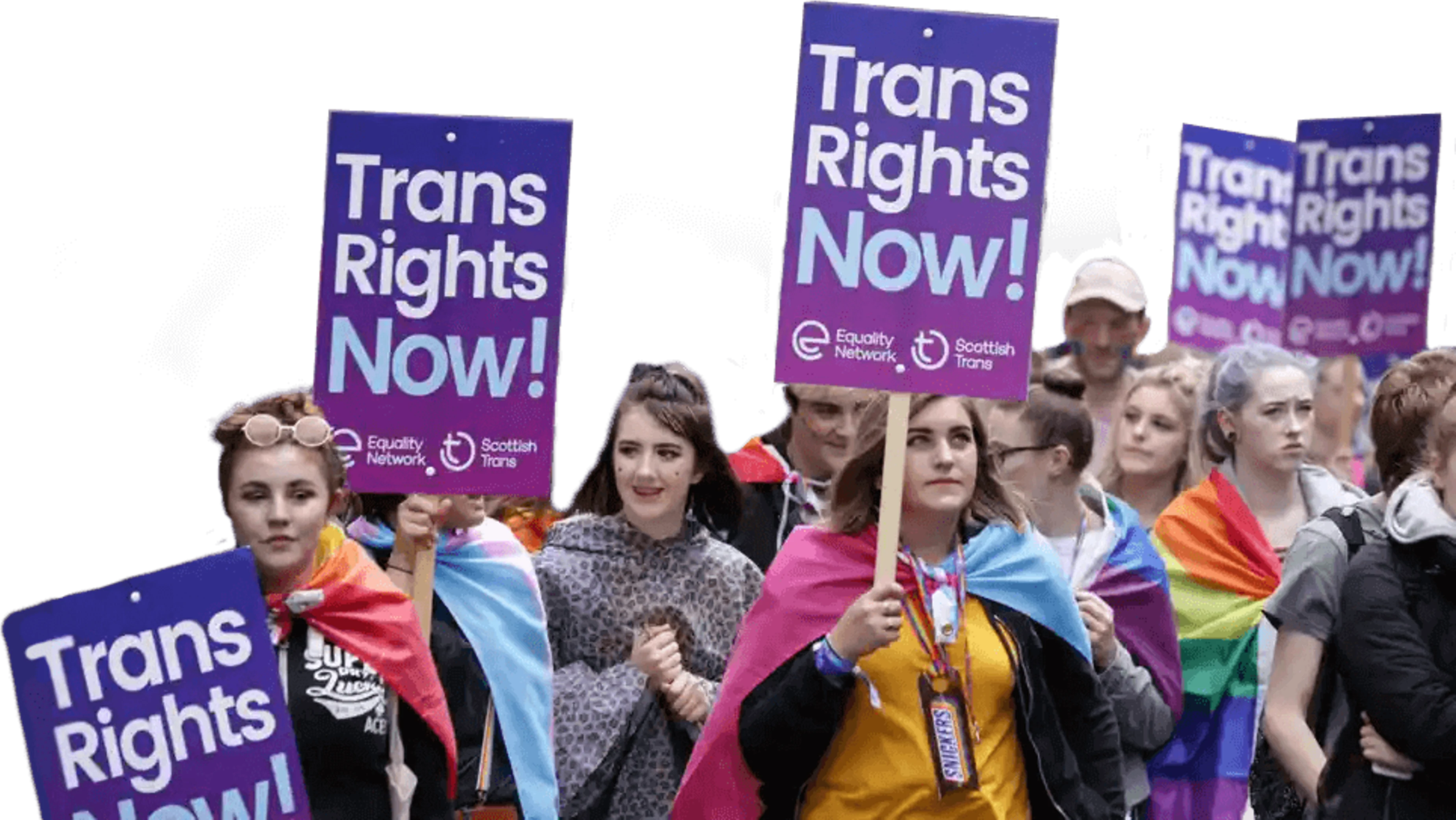The gender identity struggle. When feelings don't reflect facts.


Until Lia Thomas stood tall and smiled valiantly atop this year’s NCAA 500-yard freestyle swimming podium, I believed that advocating on the trans agenda was morally righteous. Like most young people I was convinced that I was on the right side of history. But as Lia soaked in her victory, I had a lightbulb moment that triggered a chain reaction towards understanding, plainly and explicitly, the hypocrisy and fallacy of our position. For standing beside the gleeful winner, were seven of Lia’s fellow contestants silently despairing over her participation in the women’s division which, until now, protected them from the indisputable over-dominance of the ripped male physique of which Lia is a benefactor; leaping from rank 65 in the NCAA Men’s champions 2018/19 to 1st in the Women’s championships 2022. It presents us with uncomfortable questions. If feminism is about female empowerment, what do we do about a cause that squanders women’s achievements? And if transgender women are still male in their blood, veins, and muscles, are they ever really women?

Yes, you will call me transphobic. But the irony is that you are, in your own measure, a perpetrator of anti-feminism. The sort of anti-feminism that makes a mockery of women’s hard-fought equality. As Reka Gyorgy, a 2016 Hungarian Olympic swimmer, writes in a letter to the NCAA, such brazen backing of the trans agenda is “disrespectful to biological females”, especially in sport. The reality is that although Lia has undergone the transitionary procedures, low levels of testosterone for 36 months do not negate 20 years of the muscle-massing, height-boosting, stamina-soaring hormone. Indeed, increased testosterone levels demonstrably and uncontrovertibly improve endurance performance by over 8%; conferring significant advantages in longer races such as the 500 yards. It is ironically contradictory that under IAAF regulations, the use of testosterone to boost levels to that even of the natural male range is considered doping, punishable by a minimum ban of 4 years. But even after these 4 years, the benefits of such steroids last decades. And needless to say, this advantage takes a lot longer than 36 months to undo. So why then, has this transgender woman been allowed to dope by equivalence for 20 years, yet still qualify for the race when, by their own definition, it is cheating? The answer, in the best case, as Stonewall promotes, is inclusion; the mindfulness to not offend and the courtesy to accommodate, which, on the face of it, is completely moral. But when did one person’s feelings outweigh the feelings of the many? And when did one person’s feelings become more important than the harm those feelings cause? Evidenced truth has been ignored in favour of moralistic ideals. In the name of inclusion and the fear of causing offence, the scales of equality have been unbalanced. Where women once thrived, stronger and faster converts will dominate. It is causing harm and the scales will only continue to contort.

Skewing the scales unabashedly are a passionate and vocal minority, behind whom most of us young people robotically applaud and promote. “Trans rights are human rights”, they say. And indeed they are. Most, if not all of us, support the campaign for equality, or as queerevents.ca puts it, “the right to exist without fear of harassment, violence and discrimination simply because we are transgender”. Like any minority, transgender people deserve protection from unsavoury characters and discriminatory behaviours. The confusing context about this is that they already are protected. Under the Equality Act 2010, it is illegal to discriminate against someone because they are transgender. The transgender person in question does not even need to have undergone any specific treatment or surgery to be protected from this discrimination and the act covers even the simplest of things. For example, refusing a trans woman's entry into a female toilet is unlawful. In any case, if any of us were witnesses to discriminatory behaviour, I am hopeful that we would step in to defend the discriminated. So considering the law already grants a transgender person equality, what then, are we advocating for when we clap the trans rights activists? According to organisations such as the National Center for Transgender Equality and Stonewall, the major hurdle left now is the unequivocal recognition that a transgender woman is unambiguously a woman and always has been. From granting trans people unvetted access to single-sex spaces to housing trans people in the gendered environment they identify with, trans people must be perceived solely as the sex they self-identify as, across all settings. Scotland has gone so far in this, as of February 2022, to allow people to self-identify their gender on the 2022 census regardless of their legal status. And in England and Wales, similar legislation, allowing people to legally change gender through self-identification rather than medical diagnosis, applicable generally, was drafted although not yet implemented. If the trans rights vision is to be achieved, however, this clearly does not go far enough. In this “equal society”, the distinction between men and women must be reduced solely to how we feel. And, as in the swimming championships, this is a harmful path to tread.
Last year, for example, an unnamed woman came to the edge of a severe nervous breakdown during a 12-month-long struggle to convince the police that she had been traumatically raped in a single-sex hospital ward. Instead of simply believing her, as the #MeToo movement pushed for and as most feminists would approve, the hospital, which is also unnamed, denied the possibility of a rape and did so for an entire year, effectively calling her a liar and causing unimaginable distress. It was only when CCTV corroborated the patient’s events that the hospital finally admitted that the woman was probably raped by a transgender patient. What happened to supporting the victim?
When police were called to the hospital, staff told them that ‘the rape could not have happened’ because 'there was no male' on the single-sex ward. The reason for their denial? Accommodating feelings.
It is a broader issue than just one hospital. Under the NHS’s Annex B policy, transgender people should be accommodated 'according to their presentation: the way they dress, and the name or pronouns they currently use', rather than their biological sex at birth. As such, patients are placed on single-sex wards depending on the gender they feel they are. And, in kind, if there is a trans woman in a female ward, and if anyone complains, ward sisters and nurses are instructed to tell the complainant that it is not true - there is no male there.
The story is similar in the prison system. Instead of separating prisoners on biological sex, inmates are placed on wards depending on their feelings, meaning transgender women could feasibly be and have historically been, placed in female wards. If the implications of this were not predictable, they have explicitly demonstrated through a series of incidents in which female prisoners were sexually assaulted or intimidated by transgender inmates. Most notoriously, Karen White, a trans woman who had neither surgery nor hormone treatment, “was sent to HMP New Hall, which houses 360 women, despite being a convicted paedophile on remand for grievous bodily harm, multiple rapes and other sexual offences against women.” Unsurprisingly, over their three months in prison, Karen White sexually molested four female inmates including fellow inmate Cheryle Kempton, who lamented: ‘I felt vulnerable and uncomfortable in her presence. We all felt like that, even the toughest of us. She had a manly body. It's just human nature that men are stronger than us. And we all knew Karen was stronger than us. If she got hold of us she would overpower us.’ — and she did. Cheryle was groped repeatedly in what is described as a “reign of terror”. Now no one is suggesting that all transgender people, or even a majority, are a threat in any way. But quite simply, in the name of inclusion and the fear of causing offence, truth is denied at the cost of potential harm.
In medicine and pharmacology, this harm can be monumental. When scientific studies depend on the accuracy of their measurements, the fluidity of gender for the sake of inclusion can skew studies and give false outcomes. There is now growing concern in the scientific realm that mere self-identification leads to mis-sexing individuals resulting in a physiological mismatch between asserted sex and anatomy, causing misrepresentations in clinical cohorts and errors in medicinal prescriptions; both of which ultimately reduce patient safety and drug efficacy, especially when the physiological differences between the sexes inform clinical trials and care, as is the case for the dosage of the sleeping pill zolpidem, which has a lower starting dose for women. There are of course workarounds for these problems, such as the recognition that transgender women are biologically male, but to do this would be a contradiction to the agenda of the movement and, certainly, unwelcomed.

In response to the above poster, a critic tweeted in response "@PlymUni don't seem to care for their female students as shown by this sign that's meant to gaslight women into silence." The university rebutted the criticism by announcing that "It is important to ensure that our whole University can feel safe, respected and empowered." — That is, it seems, unless you are a woman who feels uncomfortable with this arrangement because your feelings on this matter, it appears, are irrelevant. There is a growing sentiment that puts trans people’s feelings over the feelings of the wider community. If the aim is to make ‘the whole university feel safe, respected and empowered’, why aren’t women made to ‘feel safe’, comfortable, and protected too?
At this point, trans rights activists will jump at the “trans people are dangerous” trope; denouncing those who raise concerns as bigoted. Their campaign for trans rights, whatever they are, is unconditionally righteous after all. Owen Jones, a popular and otherwise admirable journalist, for example, equates the trans cause to historical struggles like the Women’s Suffrage movement or the Gay Rights campaign. The key difference, however, is that such movements caused no harm to those involved and those not, even if some media promoted slander against the oppressed. Although today, the media can be unfairly spiteful towards trans people, it is important to distinguish between outright maliciousness and valid concerns. And when it comes to the trans movement, our rash decisions on the back of ignoring these concerns can, and have, hurt people. And they have done so because it is clear now that these decisions do not reflect reality. No matter what we feel and what we appear to be, we cannot change fundamental truths.
The world we live in has inherent rules that we must play by. If I add two numbers together, the result is always the same. If I drop a ball from my hand, it will always fall to the ground.
A point in case: If I were to paint black and white stripes on a horse, could we put the horse in the local zoo and call it a zebra? Maybe not. Perhaps I then put the horse under the knife, inject it full of drugs and sew a mane on it, does it then become a zebra? It would certainly look like a zebra. But if I were to inspect the supposed zebra’s karyotype, the chromosomal structure that determines its muscles, stamina, and sex, we would find that the animal suits a stable, not a zoo. The horse was born with its makeup engraved into its very bones. And while we can change its physical appearance, no matter how many drugs one takes, no matter how many organs one severs off, nothing can change the gender binary. The horse will always be a horse, regardless of its gender dysphoria.
We can say the same for trans women and trans men. Yes, we respect their right to believe what they want, we treat them equally, and we are unwaveringly respectful; like any empathetic, reasonable person would be. But that does not mean we must lie to ourselves about definitions that have existed since the dawn of mammals. Men have XY chromosomes, Women have XX chromosomes; and again, no operations or treatments can yet change the gender binary. And if one denies this truth, we hit a roadblock in the conversation.
Our focus on feelings has left us stranded. If a woman isn’t defined by genetics, but by how one feels — their "gender identity", several essential questions are raised -- and they self-contradict. “What is a woman?”; “If it is just a feeling, why do transition procedures occur to make them appear like the opposite sex?”; “If it is about appearance, then is a woman defined solely by appearance?”; “Is it a mix of both?”. You may think these questions are irrelevant, but their answers inform our collective policy. There is an aesthetic destination in mind for what a typical woman is: a human with female genitalia. Some trans women undergo surgery to reshape their penis into a vagina and manifest non-functional breasts. But just like the horse who imitated a zebra, we know deep down that trans women are not actual women, regardless of their transgender identity or sexual orientation. When we allow these non-women to enter women-only competitions, women-only spaces, and women-only services, we are lying to ourselves. We accept trans women's right to happiness, but to accept their happiness as truth and collective policy based purely on their minority feeling, would not only be delusional, but harmful too.
Perhaps it is easier to lie to ourselves rather than hurt the feelings of the minority group whilst hurting more people in the process. To ignore the wider truth for convenience, comfort, and non-confrontation. To simply say, as one observer put it in response to Lia Thomas’ victory in the swimming; “she is a great swimmer”. I would have once said the same. But I see now that I cannot call myself a feminist and trans activist at the same time; that I cannot stand idly by when people are hurt and call it “progress”; that I cannot ignore the truth any longer simply because it is safer to do so, socially and professionally.
Perhaps the truth does not matter? But if you believe it does not, that scientific truth is unimportant, I suggest you go back to the 1800s when women were less intelligent, white people were superior and climate change didn’t exist. Believe in all truth or no truth. There is no “my truth”. There is no in-between. Yes, trans’ feelings are valid, transgender people should be respected, and their existence should “not be denied”, but I can call you a friend and disagree with your ideology simultaneously. And in the nature of healthy debate, I am open to being persuaded the other way. However, I suppose you have little interest in discussion. So go on, call me a transphobe.
Written by
Ben LawrenceLondon-based Data Analyst who should be doing a bit more exercise. Interested in current affairs and enthusiastic about the debate of the day.
Read next
Support trans people because our safety matters. Not to be on the “right side of history”

K.M. Noble
It’s not just the Met – why do police keep getting it wrong?

Eleanor Luxton
What happened when I ditched self-empowerment and embraced critical thinking

Maite Oxford
Weekly emails
Get more from Ben
The Fledger was born out of a deep-seated belief in the power of young voices. Get relevant views on topics you care about direct to your inbox each week.
Write at The Fledger
Disagree with Ben?
Have an article in mind? The Fledger is open to voices from all backgrounds. Get in touch and give your words flight.
Write the Contrast